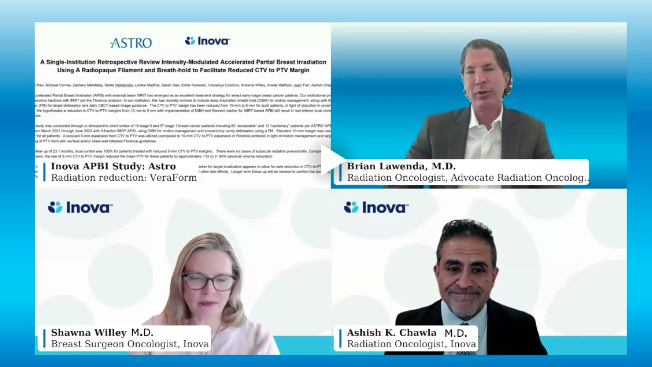
Sept. 30, 2024 – A recent study accepted by the American Society of Radiation Oncology (ASTRO) for their annual meeting in Washington D.C. demonstrates a significant reduction in radiation Planning Target Volume involving patients who received Breast Conserving Surgery (lumpectomy), a VeraForm marker for cavity delineation and Accelerated Partial Breast Irradiation (APBI) along with Deep Inspiration Breath Hold (DIBH) for motion management.
VeraForm is a 3D, radiopaque marker developed by Videra Surgical. The significant findings yielded patients an average of greater than 80 percent absolute radiation volume reduction during treatment.
Conducted by the Inova Health System in Virginia, the study involved 76 lumpectomy patients, and following surgery, patients received 5-fraction external beam APBI with deep-inspiration breath hold (DIBH). The study, conducted with two-year follow-up, demonstrated a substantial reduction in PTV (>80 percent average) without reduction in local control.
“This study showed that applying the benefits of APBI using advanced target delineation with VeraForm and motion management allows us to treat less normal breast tissue, which reduces the overall radiation exposure for our patients," said Dr. Ashish Chawla, Department Chair, Radiation Oncology, Inova Schar Cancer Institute. With VeraForm, we are more confident with the delineation of our tumor bed cavity; our target radiation volumes are established by defining the cavity accurately,” continued Dr. Chawla.
“Any time we can effectively reduce the amount of radiation a patient gets, that’s to the patient’s advantage. With excessive radiation, there are unfortunately side effects,” offered Dr. Shawna Willey, Petersen Chair & Director Breast Surgical Oncology, Inova Schar Cancer Institute. “The precision with VeraForm for tumor bed delineation is what this study is all about. Providing sound cancer treatment and getting the right amount of radiation to the right place while sparing the healthy tissue is the goal,” followed Dr. Willey.
The abstract and a discussion from key Inova physicians involved in the study may be found here.


 December 03, 2025
December 03, 2025 








